Save the Monarchs!

The Amazing Monarch Butterfly
Monarch butterflies themselves need no introduction. Their bright orange and black wings are well known to every school kid. The heart of the Monarch's summer range is the midwest U.S., but they range from Canada south of Hudson Bay, all the way down through Mexico, Central America, and into northern South America. They have also been introduced overseas in Hawaii and Australia and are occasionally found wandering as far as Greece and Malaysia. Monarchs are just one species in a family of about 300 species of Danaidae or 'Milkweed Butterflies” which range worldwide.
Amazingly, these tiny, delicate insects migrate annually up to 2500 miles from their summer homes in the United States to their winter homes in central Mexico (for western monarchs, to southern California). Even more amazing is that there are several generations of butterflies each year, and only the last generation lives to embark on a mass migration in late-September or October. This means that each year a new cohort of monarchs fly to their winter ranges, and somehow the same populations of butterflies end up in the very same trees as their ancestors. No one knows exactly how they are able to navigate these incredible distances with such precision.
Another new generation of adults return from this epic migration in early May, and the females immediately seek out milkweed plants on which to lay their eggs. These eggs develop into brightly colored black, white, and yellow-striped caterpillars. They are entirely dependent on leaves and other parts of milkweed plants for nourishment; there is no other food that they can eat. The characteristic milky sap of milkweeds contain alkaloids, latex and other compounds that make the plants toxic to most other animals. Only a handful of insect species are able to consume milkweed plants without being killed.
In the case of the monarch caterpillars, they are able to store the toxic compounds in their bodies for the rest of their lives. The bright colors of both the caterpillars and adult butterflies are a warning to would-be predators that the insects are not safe to eat. This warning is so effective, that another species of butterfly, the viceroy has evolved to almost perfectly mimic the wing patterns of monarchs. Viceroys are not closely related to monarchs, nor are they toxic, yet their similarity to monarchs provides the protection from predators.
As adults, monarch butterflies drink nectar from flowers for nourishment. Milkweed flowers are a great nectar source for a variety of butterflies, and monarchs are one of many species that help pollinate milkweeds. But of course, milkweeds don't bloom all season long, so monarchs and other butterflies also drink nectar from a variety of other native wildflowers such as joe-pye-weed, blazing star, nodding wild onion, thistles, goldenrods, asters, black-eyed susan, vervains, bellflowers, bergamots, and many more. Just like the monarchs and milkweeds, each of these plants have their own unique stories and their own relationships with many other insects and other creatures that rely on them for resources and provide services for them such as pollination.
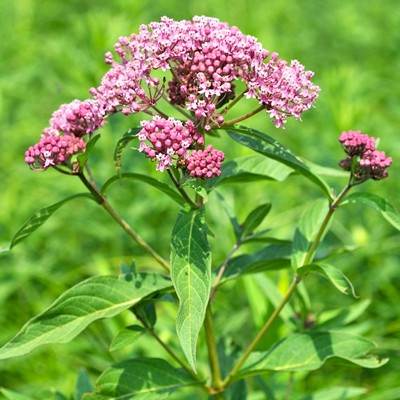
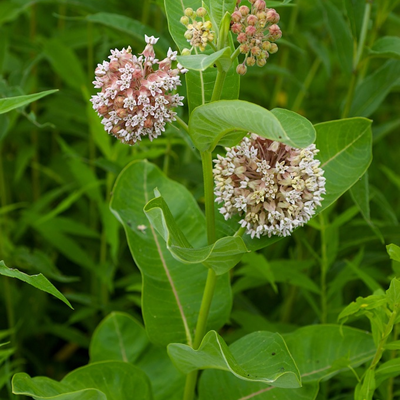
Traditional Threats to Our Beloved Monarchs
Habitat Loss in the US
Habitat loss is a big issue. It has been going on here in the US for almost 200 years as the vast prairies and savannas of the midwest, once bountiful with over a dozen species of milkweeds for monarch caterpillars to munch on (and the many other flowers the adults nectar on) have been nearly eliminated. Only 1% of the original tallgrass prairie remains in the midwest. Oak savannas are now a “globally imperiled” ecosystem with just .01% remaining of the original oak savanna that once dominated southern Wisconsin. Most milkweed species are now rare or endangered. Really, shouldn't any creature which has lost 99% of its habitat be considered 'endangered'?
There are over 70 species of milkweed in North America and 13 native to Wisconsin. They live in a variety of habitats from woodlands to wetlands, but most species prefer prairies. As you might expect, most milkweeds are fairly rare since they require these pristine habitats for homes. Dwarf milkweed, Sullivan's milkweed, and woolly milkweed are considered threatened in Wisconsin. Purple milkweed is endangered with only scattered populations left, and Mead's milkweed has been extirpated, eliminated from the state entirely.
Fortunately for the monarchs, common milkweed (Asclepias syriaca) is one tough plant. In addition to its original prairie habitat, it's able to survive and thrive in roadsides, pastures, waste areas, and even cultivated fields. It can even hold its own against aggressive invasive plants. Because of the fortitude of this colony-forming milkweed, it has remained abundant on our landscape, even in the face of the massive changes to the environment that settlement, and later industrial agriculture and urban development have wrought. It is no exaggeration to say that without the hardy common milkweed, monarchs would probably have gone extinct already.
Pesticide Use
Many petrol-chemical pesticides, such as DDT, were developed during World War II, and were put into civilian use as early as the 1950's. In many cases insecticides meant for mosquitoes or crop pests have 'drifted' out of wetlands and agricultural fields and killed many other insects unintentionally. They also killed larger animals such as songbirds that rely on these insects for food. These impacts were soon noticed by pioneering environmentalist like Rachael Carson, author of Silent Spring. With modern environmental regulations, pesticides are more carefully tested before being allowed to be sold, and are typically used in a more limited and careful fashion. But incorrect use of pesticides can still threaten monarch populations, especially since environmental regulations are aimed at protecting human health, with less emphasis on potential wildlife impacts.
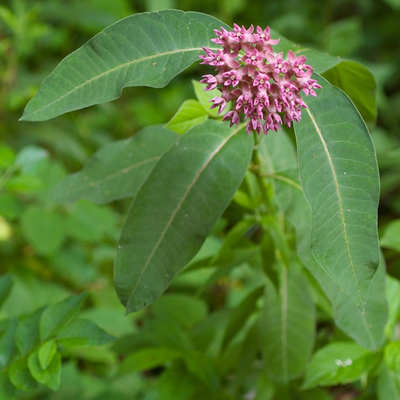
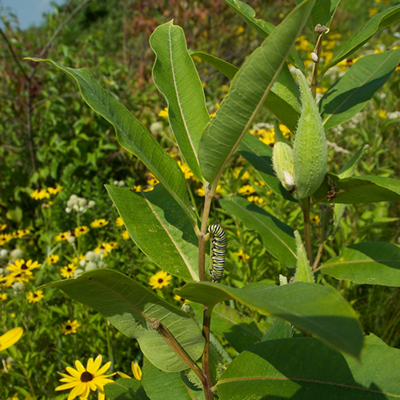
New Threats to Monarchs in the 21st Century
In recent years, there have been new pressures that have threatened even common milkweed and the monarchs more directly. In just the past decade monarch populations have declined dramatically due to new pressures:
Genetically Modified Organisms
Many people are worried about potential human health threats that genetically modified organisms (GMOs) might pose. Unfortunately, they are most definitely a threat to the health of monarchs and other beneficial insects right now! The widespread use of Round-Up Ready® crops is resulting in a much higher use of this herbicide. As a result, milkweed plants in and adjacent to agricultural fields are being killed by herbicide drift, leaving no food for the monarch caterpillars. Over 100 million acres of monarch habitat have been lost due to the extensive use of Round-Up Ready crops.
Then there is Bt corn, which has genes from bacteria spliced into their chromosomes that allows this corn to produce insect killing chemicals. The pollen from this corn also has these insect-killing properties. There is some evidence that this pollen can weaken or kill monarch caterpillars feeding on nearby milkweeds (not to mention the many other insects feeding on other nearby plants, though the intensity of this effect has been disputed.
More Habitat Loss in the U.S.
With the recent spike in corn prices, farmers are tilling up fallow fields and meadows in order to cultivate as much land as possible. Much of this land has been in the Conservation Reserve Program for decades and is often habitat for common milkweed. Coupled with ever-expanding urban development habitat loss continues to be a primary threat for milkweeds and monarchs today.
Habitat loss in Mexico
The monarchs overwintering site in Mexico is also under threat. Remarkably, all of the monarchs from east of the Rockies - billions of butterflies - overwinter on trees in one particular forested area just a few acres in size. The number of acres they cover is one way that monarch populations are monitored. For example, according to Monarch Watch, the long-term average area that monarchs covered has been 17.9 acres. This area has been dropping steadily since they began monitoring in the mid-1990's. In the winter of 2013-14, monarchs covered only 1.7 acres of forest. These forests themselves are under threat from development in the forms of road building and logging for building materials.
All of these impacts have resulted in what is being called monarch population decline. These fascinating butterflies are not the only organism that are imperiled by threats to our local ecosystem. They like every other butterfly, bee, bird, and every other wild creature, they are all interdependent on each other and the plants, fungi and many other organisms. Monarchs are a colorful "poster child" for the many other equally interesting and important organisms who will all benefit from conservation efforts. We have saved the bald eagle and osprey from the brink of extinction. We can save the monarchs too. How you manage your yard can be an important part of the solution.
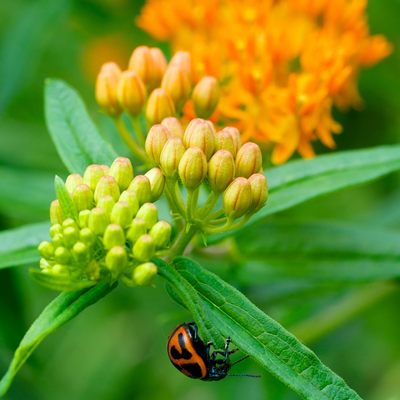


How You Can Help Monarchs on Your Property
- Plant a butterfly garden. A garden with milkweeds and a mix of native perennial flowers can provide everything that monarchs and other pollinators need to grow and thrive. You'll be amazed how quickly the monarchs and other interesting insects find these gardens, giving you and your family a chance to learn about these fascinating creatures first-hand. We can install a butterfly garden for you, or provide you with a kit so you can plant your own. We have already done the homework and have picked out plants that not only provide the monarch caterpillars with food, but also flowers that bloom all summer long to provide the adults with nectar.
- Go native with your landscaping. Integrate native plants into your existing perennial beds, or convert some (or all!) of your lawn to native perennials. planting a variety of native perennial flowers and grasses can provide great wildlife habitat and natural beauty. If you're not using part, or any, of your lawn, why mow it every week? Go native and let the pollinators use it instead! Again, we can do all the work for you, or provide you with the plants and instructions to do it yourself.
- Never use insecticides to control pests on your property. There are many old-fashioned organic methods that can help you deal with insect pests.
- If you already have milkweeds on your property preserve them. Common milkweed will often show up along the weedy edges of a lot. It is best to just leave them be (or even encourage them!) Especially if you have a large rural property with old field or pasture, this can provide a lot of monarch habitat. Better yet, convert those fields to prairie!
- Control invasive plants on your property. Invasive plants can push out native wildflowers on which monarchs and other wildlife depend. The biggest threats are invasive shrubs like buckthorn and honeysuckle that can shade out milkweeds completely.
- Choose organic food products. These foods are made without the aid of pesticides, meaning organic farms work with, not against native insects like monarchs.
- Donate to local conservation organizations. Organizations that focus directly on monarch conservation such as Monarch Watch and are great, but organizations that preserve, restore and sometimes outright purchase natural habitat like The Prairie Enthusiasts, The Nature Conservancy, or your local land trust can turn your donation directly into quality habitat, not just for milkweeds and monarchs but for all the beautiful and interesting creatures native to our region.
- Make your voice heard, encourage your local, state and federal government agencies to provide and protect native wildlife habitat. This action can range from establishing an educational butterfly garden in a local park to lobbying your legislators. Sadly, vast areas in many state parks are covered in Eurasian field weeds, not native plants, and in Wisconsin, almost no money is put towards preserving and restoring natural areas in state parks, forest and wildlife areas. Even roadsides could make great corridors for butterflies if they were planted to and managed for native plants. Of course, budgets are tight, but we can't try to save money today at the expense of our future.
